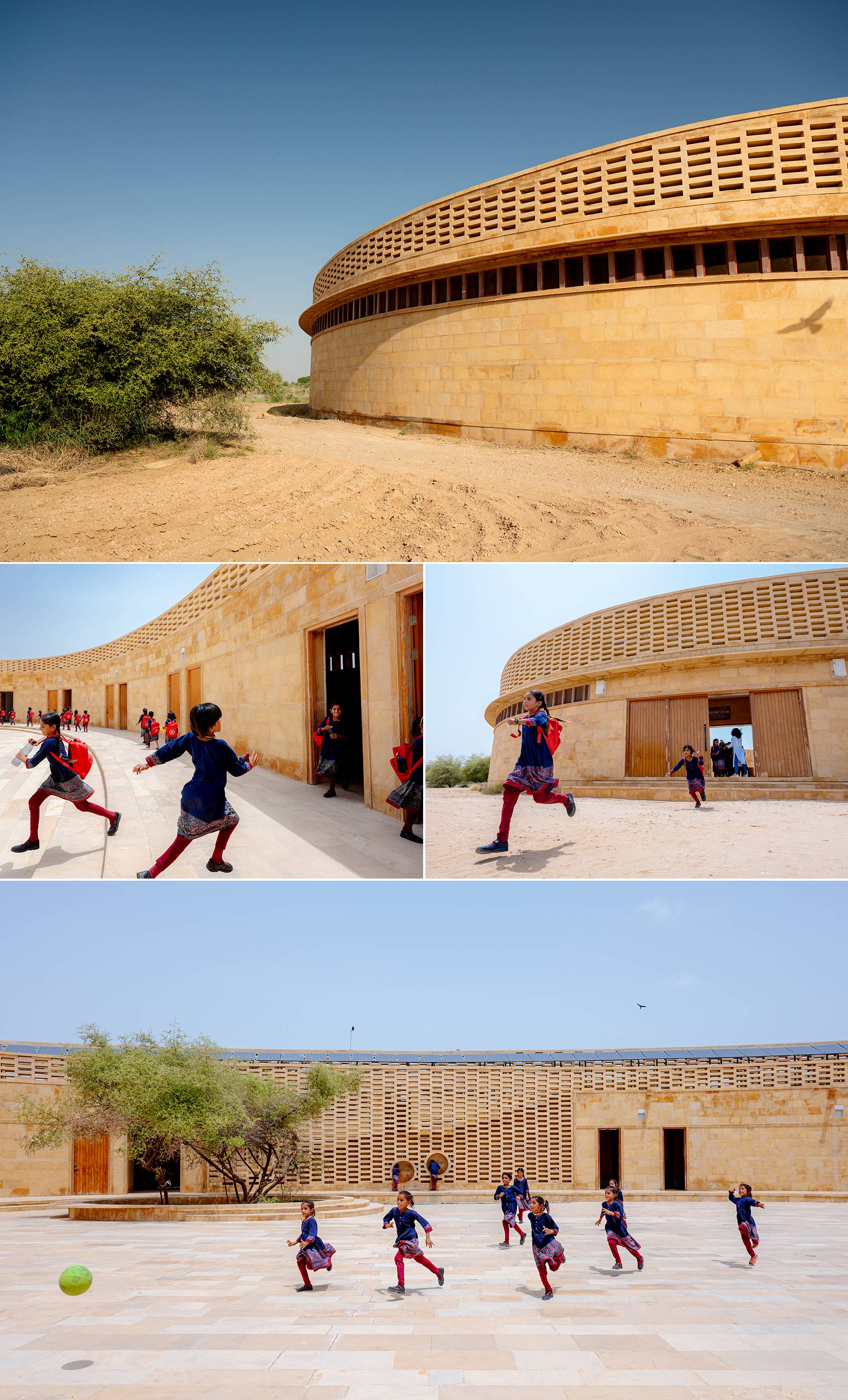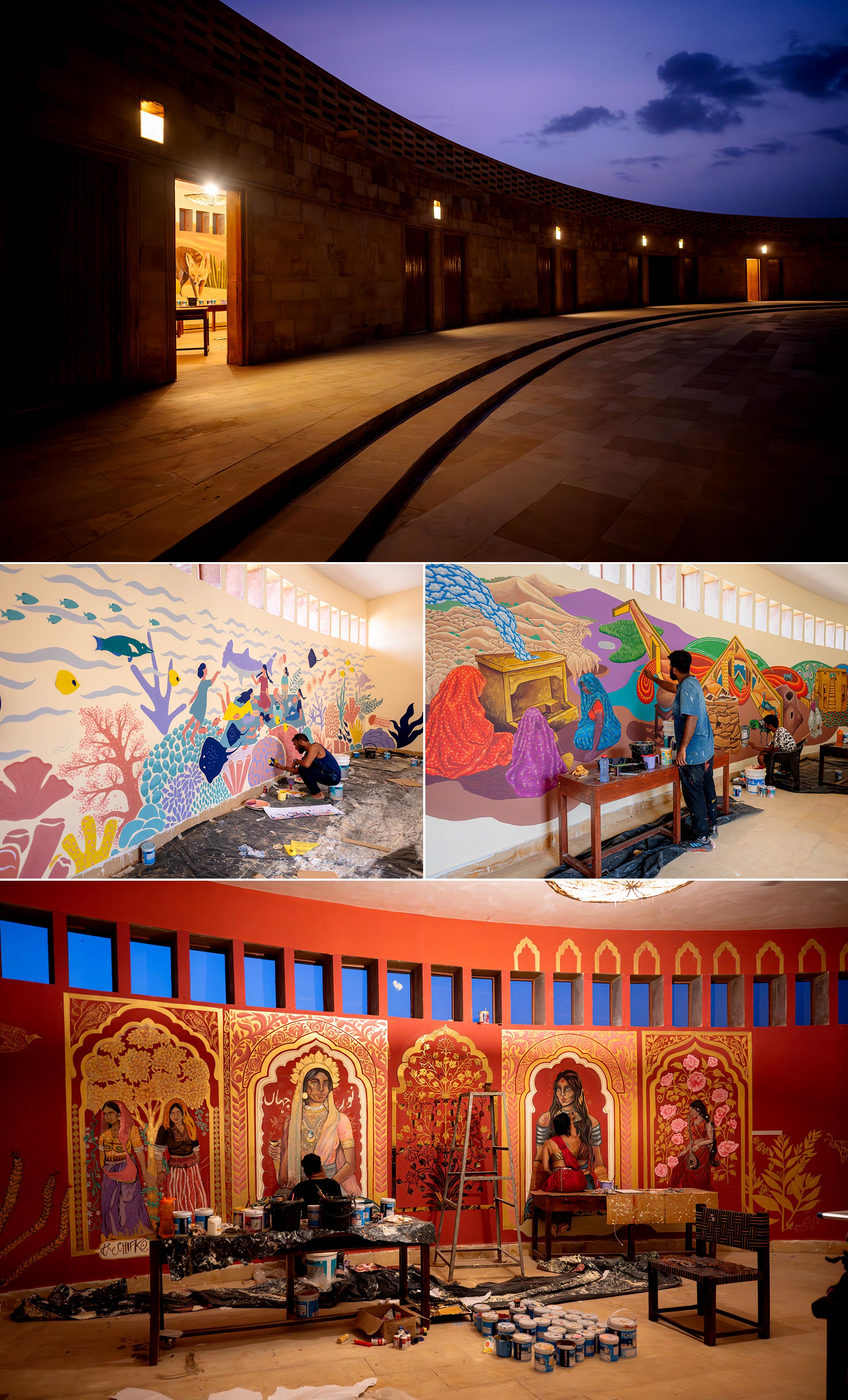
Igniting learning and empowerment through art
Amid the arid landscape of what is practically a desert, Rajkumari Ratnavati Girl’s School is seeking innovative and creative ways to balance the scales of gender inequity by empowering young girls through education. Read on to learn about one such interesting initiative that aims at igniting creativity and curiosity.
Driving into the vast empty space of Jaisalmer, one can feel the impending gloom in the monotony of the landscape. In the Thar Desert, notorious for its treachery, heat and dust amalgamate to make sustenance hard in this difficult terrain. It is in such conditions that the traditional nomadic communities of Rajasthan not only survive but thrive with their ingenious ways of living. The locals like to see the desert not as a place of scarcity but that of thoughtful abundance, where nature has graciously provided for their every need.

Amidst this, the gleeful cheer of the young girls greets visitors into their own small world. A mellifluous - “Goood Morning Ma’am!” announces the arrival of the day, as the children run across the lengths of a courtyard exploring every inch of their freedom. The sharp dresses glisten in the desert sun, contrasting with the monotone of the yellow sandstone. The atmosphere of the school is positively charged and the air, apart from the copious dust, is filled with raw emotion.

Welcome to Rajkumari Ratnavati Girls School. A part of GYAAN Center, a novel initiative by CITTA Foundation, India. A decade in the making, this institution aims to bring forth a necessary grassroots-level change to a region notorious for female infanticide, child marriage, and low female literacy rate. In order to foster an environment of growth and empowerment among the women in the Thar region, the organization plans to equip young women with the right resources. Jaisalmer, and Rajasthan in general, is known for its splendid art forms. From sculpting to music, and the traditional Kalbeliya to the vibrant textiles, the region is prolific with art.

Bringing to live a love child of art and intent, various artists conspired together to curate and create this temple of education. World-renowned architecture firm Diana Kellog Architects (New York) crafted this unique architectural design using the traditional knowledge of the desert, while acclaimed fashion designer, Sabyasachi, designed the school uniform. And, since the conception of the school, CITTA India has been collaborating with many institutions and organizations to impart state-of-the-art education to the students while maintaining a balance with tradition and culture endemic to the region. Presently, academic fellows from various research backgrounds are collaborating with the organization to create a one-of-a-kind curriculum for the students.

This time, the BALA Initiative by CITTA India has attempted to notch up the vibrance in the daily lives of the children, well, by painting their classroom walls with life. Wall artists from across the country were invited to bring along their imagination and creativity and paint them on the walls of the classrooms. Each artist brought their own unique way of seeing the world. The central theme of all artworks is interactive education, but the representation of each wall has come out uniquely. The intention was to develop a creative learning environment for the children where they feel liberated by art. Since art is something they witness as a part of their lives, the colors in the classrooms are aimed at making them feel at home.

Art has an ability to circumvent all prejudices and convey emotion without bias. It enables free thought that transcends age and intellect. The music of the Manganiars echoes in the dunes of this desert, and traditional stone carvers of this region are renowned globally for their craftsmanship. Jaisalmer, falling on the traditional trading route has historically been a hub of all things art. The children growing up, have been surrounded by art and it was only natural that their alma mater furthered their exposure.
When nationally acclaimed artists arrived at their doorstep to paint their classroom walls, the excitement among the children could be seen in their bright and eager eyes.

Artist Shilo Shiv Suleiman brought the universe of the Queens of India in her representation of the Zenana (Royal Apartments of the Queens and Princesses). She portrayed Empress Nur Jahan, the courageous ladies of the Chipko Movement, the devotional Meera Bai, and the valiant Rani Padmavati to inspire the young girls to believe what she says, “Hum sab apne dil ki raniyaan hai,” [We are all queens of our own hearts]. The girls recited the new mantra with fervor and jumped with her in excitement. Shylo believes that fostering girls at a young age with the right inspiration, especially in the form of great women leaders, can instill a sense of confidence in them and empower them with the ability to take on the world.


Artist Khatra believes that the artforms on the walls have the ability to kindle creative thought in the students and enable them to understand life better. He imagined a 3D render of the English Alphabets shadowed by their phonetic sounds in Hindi. The artwork pays its respects to the traditional language of the region while routing a creative way to learn something anew.

The kids were seen running around the freshly painted 3D wall art, many witnessing something like this for the very first time in their lives. Yogesh Choure - a teacher started using the wall art to teach the English alphabet and the new learnings were received with many a giggle by the young ones.

Shayan believes that through his rendering of the famous monuments of the world, the children would be constantly reminded of the vast expanse of the globe that lies around them. From this little room in the desert, they would be empowered to dream about the whole wide world. The girl he painted on the wall was named “Rajkumari” by a child who was spotted matching a resemblance to the colourful uniform donned by their new classmate.

While the artists spilled their talent, and their soul, on the walls of these classrooms, the children had a whale of a time interacting with them and often joining in the process. It was only natural that a lot of them took to drawing and sketching on their own, often in their notebooks or on tables and walls. The influence and impact of bringing art to their touch were almost instantly visible.

Svabhu Kohli, while charting the solar system, the star map of the Northern Hemisphere and the phases of the moon, found a creative and an aesthetic way of teaching the students to, “look to the stars, and from them, learn.” This space has a balcony seat to the universe, as the dark sky visibility here is one of the best in the world. For the students to learn about the stars in school and be able to spot them at night would be fun and educational at the same time.

An artist collective - The Trespassers - spent two days exploring Jaisalmer to understand the landscape and the people before they came up with their unique fusion of elements that stood out. The trio created a collage of each of their ideas all merged into one. Elements like pottery, the traditional cooking stove, cattle rearing, and windmills, all found a space in the one-of-a-kind representation of Jaisalmer in a classroom. Their artwork was more modern in nature, thus targeting much older kids, as it instilled ingenuity and abstraction. For many students, this was their first exposure to modern art.


The newly built classrooms became an instant hit among the students. And the sparkle in their eyes in turn inspired the artists. Some began inquiring about the paintings, while others just relished the newfound vibrance. Prachi Deva - a Research Scholar at CITTA India, believes that the long-term effect of these paintings on the kids will be profound as it will encourage creative thought and spark curiosity. Alongside, she reckons, the artistic expression of the children might also increase, driving them closer to their roots and tradition.

While one class had the numbers 1-20 illustrated on the wall, another portrayed a rendition of the sea life. Yet another artist took inspiration from the unique flora and fauna of the region and canvassed the diversity of the desert. While all the art pieces were different artistic representations, the children immediately imbibed them. A few kids were seen reciting the numbers looking at the wall, while another was seen explaining the ‘Orion’ in the sky. For the traditional communities who have not been acquainted with modern norms of education, such ingenious solutions can go a long way in bridging the gap.

One of the many children a 6-year-old said she now feels happier in her class because of all the colors. While the painting was on, she looked forward to coming to school every day in anticipation of seeing something new. A 10-year-old felt validated when she accurately pointed out the flora and fauna painted on the walls and the class clapped for her.

The artists who executed this dreamlike initiative stayed in Jaisalmer over a period of about two months (cumulatively). Some of them believe that their regular attendance at the school helped them recall their own childhood and appreciate the process. The infectious energy of the kids charged them to carry on their work with zeal, regularly reminding them of the effect the art will have on so many lives. Shayan credits the fulfillment associated with his job as the driving force behind all his efforts, while Trivendra outstayed his time due to the joy associated with painting in the atmosphere.

In a perfect symmetry of welfare action and private partnership, various organizations have contributed to the school’s growth. St+Art - an artist collective - collaborated with CITTA India to execute this one-of-a-kind project. Supported by Infosys Foundation is working to provide modern education to girls coming from an area deeply affected by social taboos and historical marginalization. This initiative fosters grassroots development as a classic example of the bottom-up approach to development and ensures the future is as bright as the sparks seen in the eyes of the Rajkumaris of Ratnavati School for Girls.




